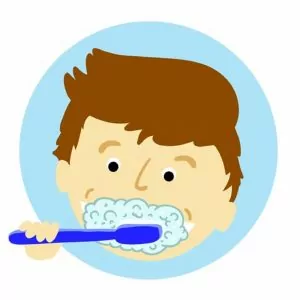You have probably been brushing your teeth for quite some time now. That’s great! Brushing your teeth twice a day is a key part of maintaining your oral health. But even though brushing is an old habit for many of us, there are still a couple mistakes that a lot of people make when doing their daily brush up.

Here are 3 ways you may be brushing your teeth wrong.
1. You are using too much pressure.
Your teeth are naturally very strong. But even strong substances can be worn down, and subjecting your teeth to repeated, excessive pressure can take its toll on your tooth enamel. Eventually, that can lead to tooth sensitivity and cavities. Brushing too hard can also have a negative impact on your gums, which, again, can increase your risk of sensitivity and decay.
When brushing, remember this: the movement, angle, and coverage is more important than the pressure. You need to brush thoroughly, but you don’t have to brush hard. Use quick, short strokes, hold your toothbrush at a slight angle, and make sure you are cleaning everywhere you need to (more on that later). If you use an electric toothbrush, you barely need to use any pressure at all.
If you struggle with using too much pressure when you brush, talk to your dentist about things that might help. One of our favorite suggestions is to brush with your non-dominant (presumably weaker) hand.
2. You are using the wrong toothbrush.
It’s hard to do the job right if you don’t have the right tools. Finding the toothbrush that works best for you is a big step toward being able to brush your teeth properly. And if you are using the wrong brush (usually one with bristles that are too hard, and therefore too harsh on your teeth), you will be more prone to the symptoms of improper brushing mentioned above (sensitivity, cavities, and gum issues).
Soft-bristled toothbrushes are universally recommended for at-home, everyday use. Choose a toothbrush with soft bristles, a relatively small brush head (you want it to fit inside your mouth comfortably), and a comfortable handle. You’ll also want to choose between a battery-powered and manual toothbrush. Powered toothbrushes are very popular these days, but remember: even powered toothbrushes don’t do all the work for you.
The last thing to keep in mind here is the age of your toothbrush. Your brush (or brush head) should be replaced about every 3 months. Replace it sooner if it starts to look frayed or worn down, or if you get sick.
3. You aren’t hitting all the right spots.
Thorough coverage is absolutely key when brushing, and many people usually have a “weak spot” or two that they consistently miss when brushing. This allows plaque to build up in those areas that are not getting well-cleaned.
When brushing, you have three surfaces to clean on each tooth: the one facing the outside, the biting surface, and the one facing inside. Make sure when you brush that you are hitting all three surfaces of each tooth. (Don’t worry, it is a lot easier than it sounds!) This should take about 2 full minutes.
Your semiannual visit to the dentist should reveal a lot about your brushing habits, and they will likely be able to tell you if there are any spots that you seem to miss regularly. Once you know those tricky spots, we recommend brushing them first and then moving into your regular brushing pattern, to make sure they don’t get forgotten.
No matter how you do it, brushing your teeth is a good habit to have. Make sure you are getting the full benefits by eliminating these 3 common teeth brushing mistakes from your daily routine. Your smile will be happier (and healthier!) because of it. Are you looking for professional feedback on your current brushing efforts? Contact Smile Concepts, Scottsdale’s top family dentist today to schedule your next checkup to make sure your smile stays healthy for a lifetime.